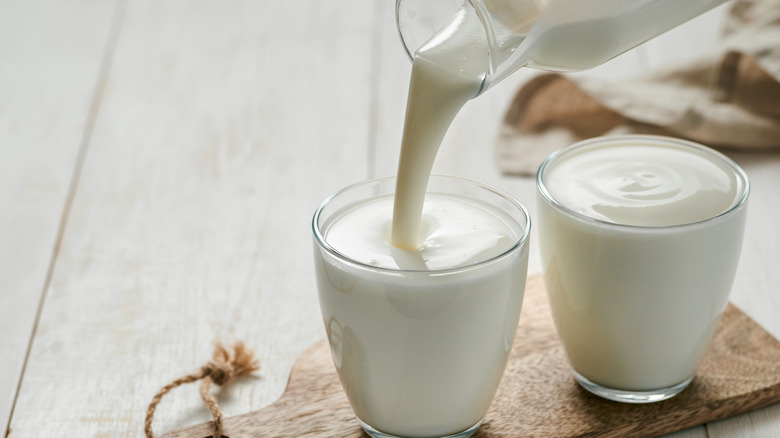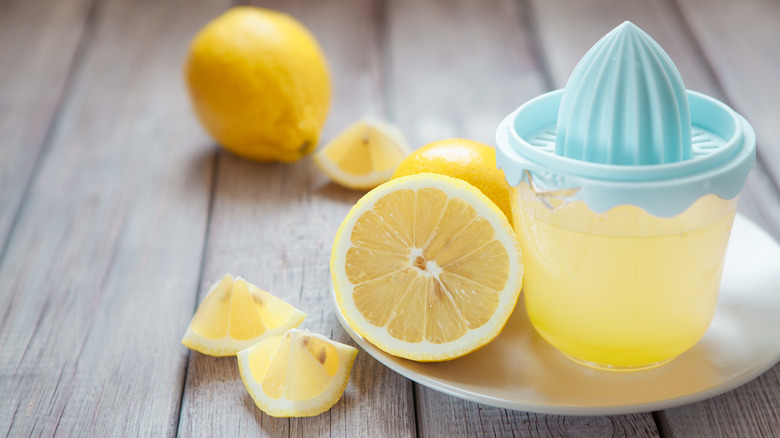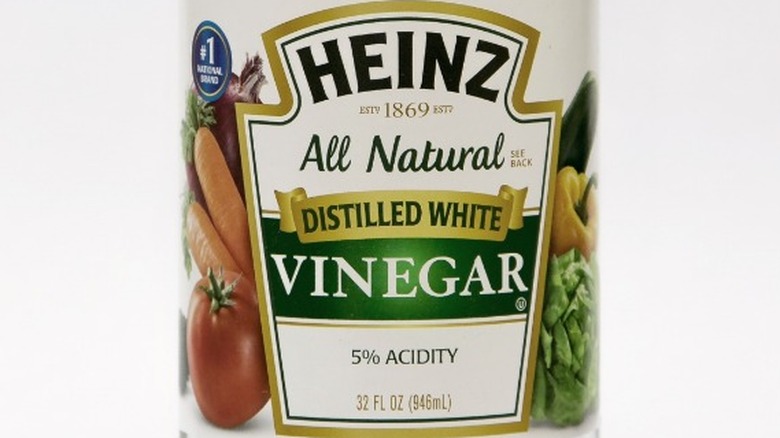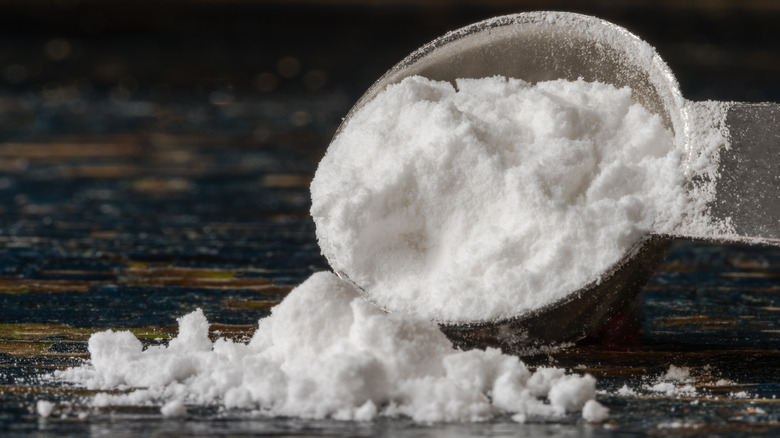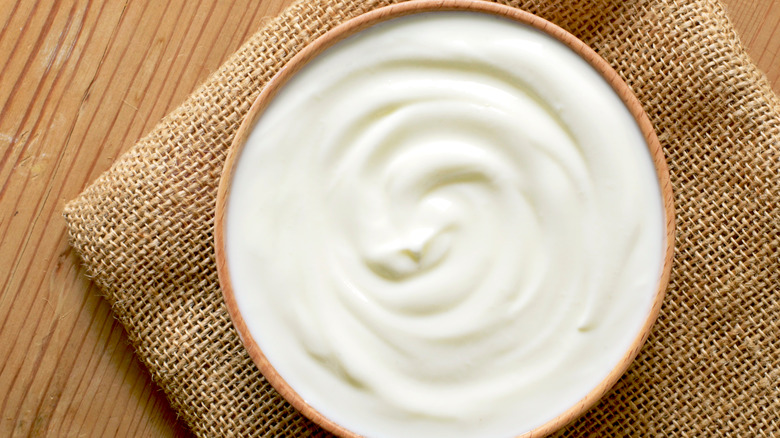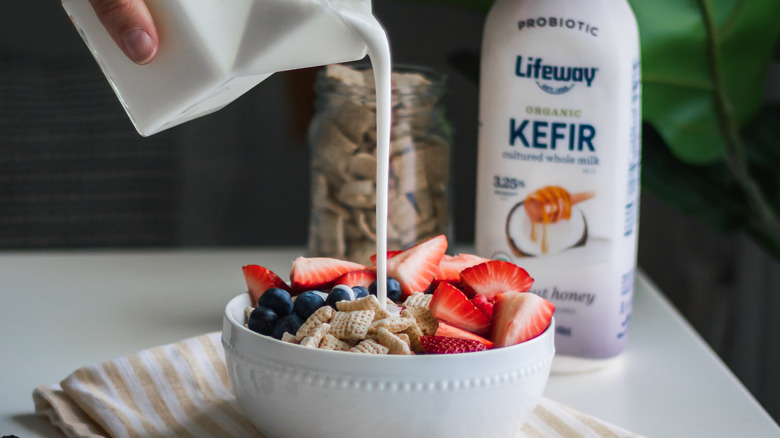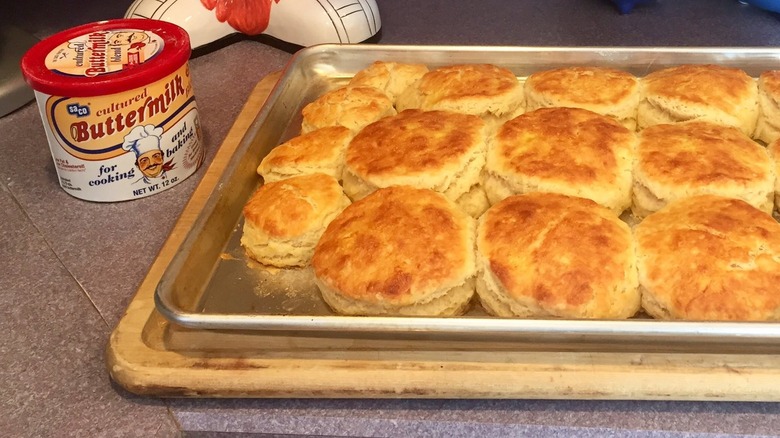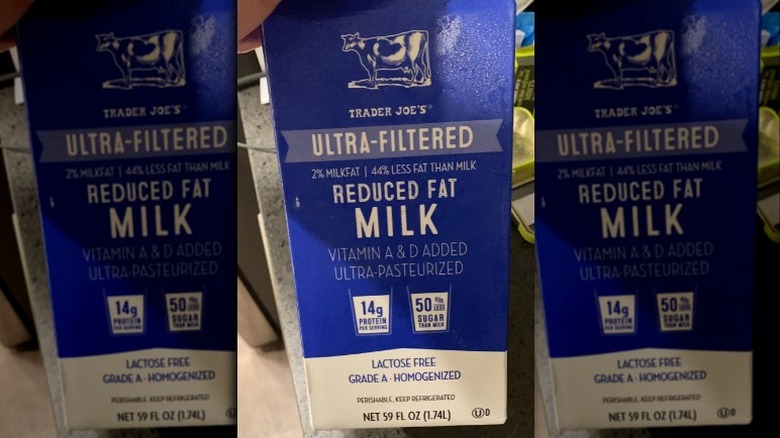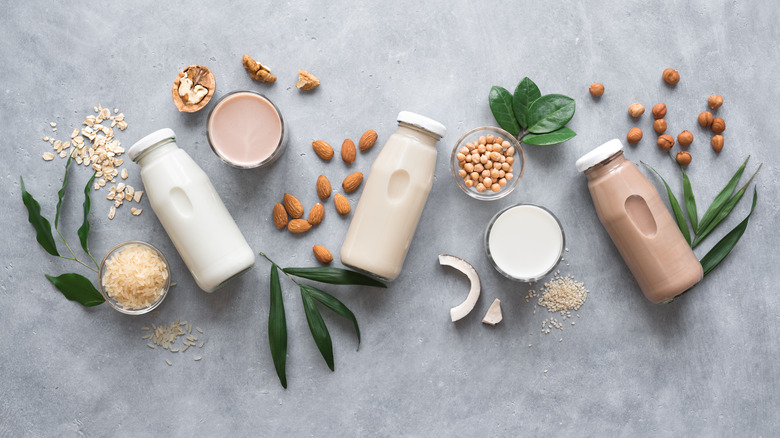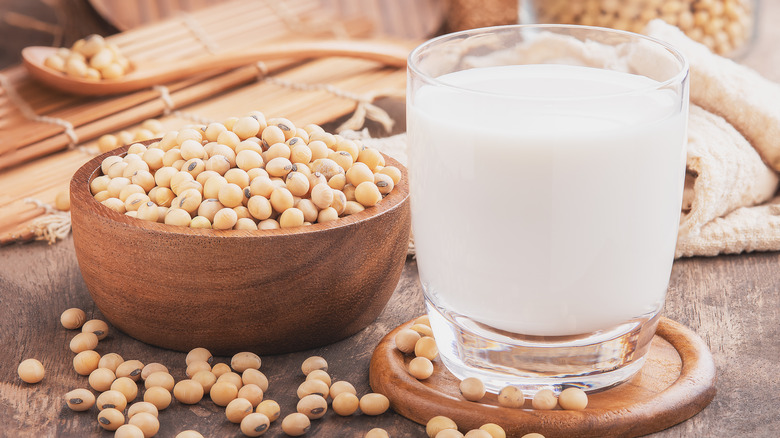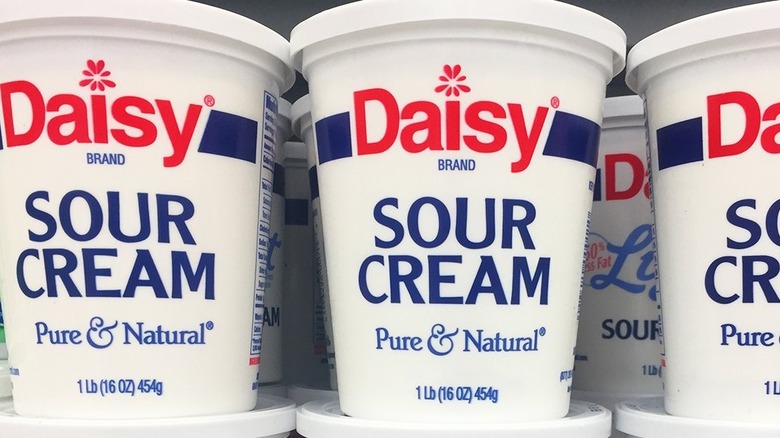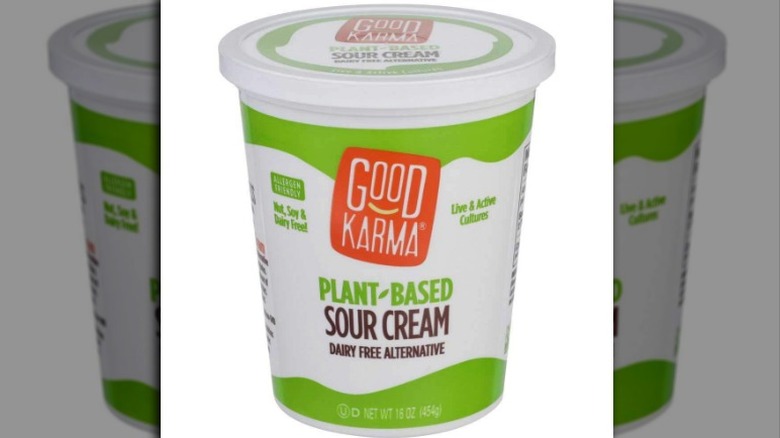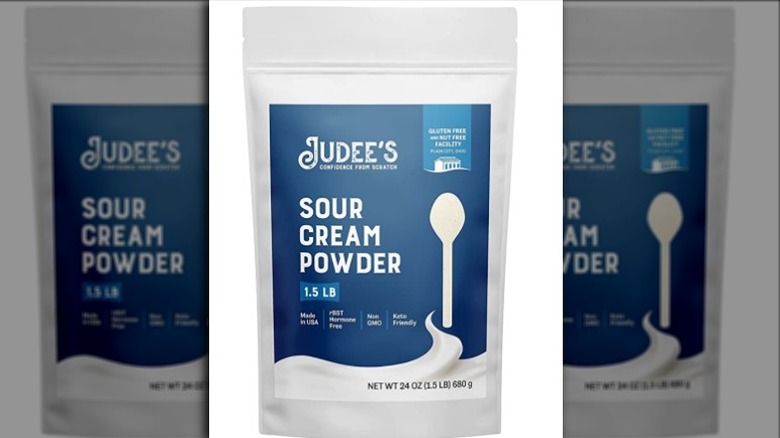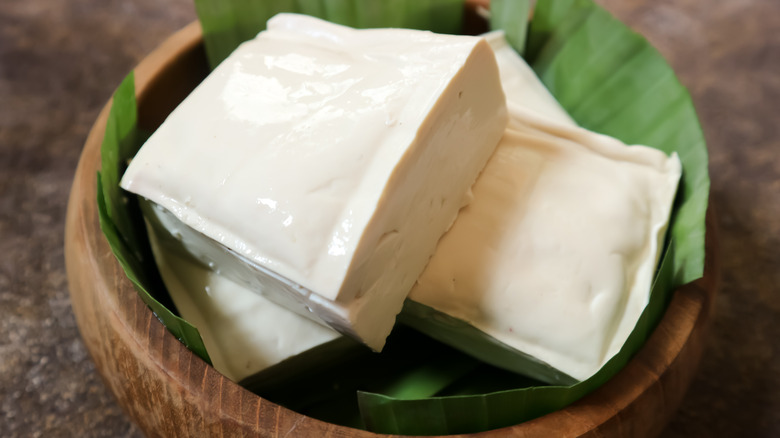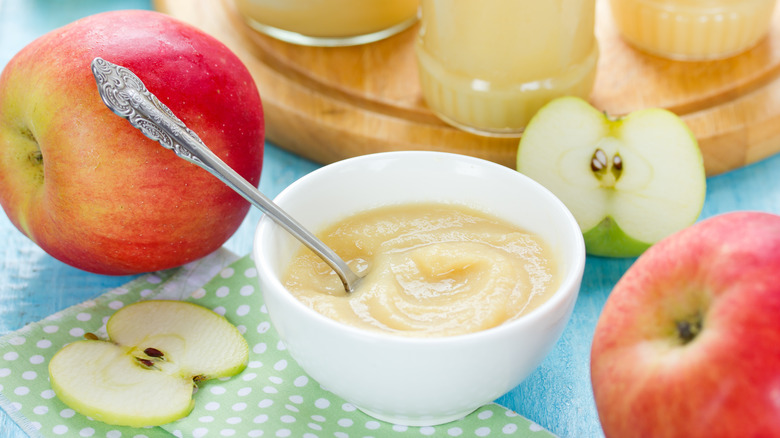14 Of The Best Buttermilk Substitutes To Use In A Pinch
Buttermilk conjures up comforting thoughts of biscuits, fried chicken, and Southern soul food classics. But what exactly is buttermilk and what does it do in baking and cooking that makes it so special? Classically, it is the liquid by-product of the butter-making process. A vat of cream is beat until the fat comes together as butter, separating the fat solids from the non-fat liquid. According to Southern Living, this liquid is then left out at room temperature for a few hours to develop natural cultures that enhance the flavor, acidity, and longevity of the buttermilk for future uses.
Most commercially-produced buttermilk is milk that has had lactic acid bacteria cultures added to it, typically producing a thicker and more acidic dairy product than milk alone. Most buttermilk is low-fat, although nonfat and full-fat versions are available. While buttermilk is a popular ingredient for baking, it was especially so prior to the 20th century. Double-acting baking powder wasn't widely available until the early 1900s (via What's Cooking America), and instead, most bakers relied on baking soda or yeast. But baking soda requires the help of an acid to reach its full potential, which is where buttermilk came in especially handy in baking recipes. It provides a creamy texture, additional moisture, a balancing tangy flavor, and just the right amount of acid to activate the leavener.
If you find yourself making a recipe with buttermilk but don't have it on hand or want a dairy-alternative to cultured buttermilk, here are some substitutes that can help.
1. Milk and lemon juice
The combination of milk and lemon juice is probably the most classic buttermilk substitute, we assume because of its simplicity and availability for many cooks. For this substitution, you'll need 1 tablespoon of freshly squeezed lemon juice per cup of milk that you need to swap for a cup of buttermilk. Stir the lemon juice into the milk and let it sit for a few minutes while the acid of the lemon juice goes to work on the milk. According to Cook's Illustrated, small curds will begin to appear in the milk shortly after incorporating the lemon juice, which is an entirely normal reaction. If you're using low or non-fat milk, you may see less of a reaction because of the lower fat content.
Lemon is typically a welcome addition to many baked goods because of the slightly fruity and floral addition it gives to the acid that balances the sweetness. Lemon juice won't likely be as strong tasting as the vinegar substitute but will be just as effective. Again, you aren't likely to notice much of a difference in thickness or creamy culture flavor here, but the acid will give a nice boost to your baking soda and overall flavor.
2. Milk and vinegar
We imagine that most households have some kind of vinegar on hand, whether it be regular household white distilled vinegar, apple cider vinegar, or a wine-based vinegar. For this particular substitution, you'll want to use the white distilled vinegar, but if all you have in the cabinet is apple cider or white wine vinegar, then that'll do in a pinch.
For 1 cup of milk, you're going to pour in 1 tablespoon of vinegar (via Taste of Home). At that point, you're going to gently stir the milk, and then let it sit undisturbed for at least five minutes. When you come back to it, you'll notice that the milk has thickened, and possibly curdled or split from the additional acid. Don't be alarmed, that's exactly what you're looking for. Give your homemade buttermilk a quick stir, then continue on with your recipe.
This particular substitution will impart a slightly acidic taste to your baked goods which is often a nice balance with sweet recipes. The additional acid will also support the proper functioning of any leaveners you're using in the recipe. Unfortunately, it won't add some of the richness imparted by the live cultures in buttermilk.
3. Cream of tartar
Not everyone keeps their pantry stocked with cream of tartar, but many bakers will have some on hand. Typically not very much of it is used in a recipe, so it can take years to go through a container of it. Contrary to its name, cream of tartar is not a dairy product, but an acid (tartaric acid) that's a by-product of the winemaking process. Cream of tartar has a lot of different uses when it comes to baking, but the one we're interested in here is its ability to acidify your dairy and activate the baking soda in your recipe.
For this particular substitution, Joy the Baker suggests adding 1¾ teaspoons of cream of tartar to 1 cup of milk. Because the cream of tartar can be a little chunky, she suggests creating a slurry with a few teaspoons of milk and the tartar first to break up all of the powder, then stir in the rest of the milk. This particular workaround doesn't add any additional cultures or substantial flavor to your homemade buttermilk, but it will help boost the acid level for a proper rise of your baked goods.
4. Yogurt and milk or water
Given the selection of yogurt brands available at the grocery store versus the selection of buttermilk at the grocery store, it seems likely that more households regularly stock yogurt — which is great if you need to whip up some buttermilk in a pinch and only have yogurt on hand. To create 1 cup of yogurt-based buttermilk substitute, Joy the Baker recommends measuring out ¾ of a cup of plain yogurt (not Greek yogurt) and thinning it out with ¼ cup of milk. You can use any percentage of milk you've got in the fridge, or even water.
Since yogurt uses similar cultures as buttermilk, not only are you getting a similar substitution in acid and flavor, but also in creaminess and culture. While Greek yogurt is also cultured and acidic, it's thicker than American-style yogurt with a higher protein content, and requires more milk or water to achieve the same texture. By thinning Greek yogurt out more, it loses some of the potency you're striving for with the acid and cultures levels.
5. Kefir
If you've never used kefir before, you might want to pick a bottle of it up and try it out with your next batch of biscuits or muffins. Kefir has more in common with yogurt than it does standard milk, and it is a fantastic substitute for buttermilk for those looking to branch out. Kefir is milk that has been fermented, but don't let that scare you off. According to EatingWell, kefir has been inoculated with at least five probiotics (which are healthy yeasts and bacterium) — whereas most yogurts only contain two probiotics, and buttermilk only contains one. During the baking process, most of those probiotics die off, but the creamy and slightly tart flavor remains. It also contributes moisture and helps with rising.
Like buttermilk, kefir is also an appealing choice for those sensitive to lactose because the probiotics feed on the lactose (natural milk sugars), and convert it to lactic acid, which is the same acid that reacts with the leaveners in your baked goods and helps facilitate a beautiful rise. Like yogurt, kefir is available in several appealing flavors, so make sure to pick up a bottle of plain kefir if you plan on using it for cooking.
6. Buttermilk powder
We get it, sometimes you don't want to buy a whole quart of buttermilk only to use ½ a cup of it and have it go bad in the refrigerator because you've got nothing else to immediately use it for. But you also like the taste of buttermilk in a recipe and don't want to sacrifice that for a substitute. Buttermilk powder is going to be your new baking best friend. It's shelf-stable, just like powdered milk, and can quickly be measured out and mixed up to the exact quantities you need, whenever you need it.
The King Arthur Baking Company dried buttermilk is sold by the pound and is mixed with one part buttermilk powder to four parts water, so it can easily be scaled to fit your recipe. You may have also noticed the SACO brand Cultured Buttermilk Blend on the shelves at your local grocery store, usually on the baking aisle, which has the same ratio as the King Arthur buttermilk powder, just sold in slightly smaller portions. Regardless of the brand you choose, you'll get similar results without sacrificing the things you love about fresh buttermilk.
7. Lactose-free milk and lemon juice or vinegar
Even though buttermilk is lower in lactose than other dairy products, it may still bother some people who are lactose intolerant. In that case, making a buttermilk substitute with lactose-free milk is just as simple and effective as making a buttermilk substitute with other milk products, and the ratio is also the same, according to I Hate You Milk. First, you'll measure out 1 tablespoon of lemon juice or vinegar into a liquid measuring cup. Then you'll fill the cup with your choice of lactose-free milk up to the one-cup line. Stir the milk and acid together, let the mixture sit for a few minutes, then proceed with your recipe as you would with traditional buttermilk.
Because lactose-free milk is made with actual milk, it's got all of the same nutrients in it that you'll find in regular milk. The only difference is that an enzyme called lactase is added to the milk, which breaks down the lactose — a process that happens naturally for those that can tolerate lactose (via healthline.com). So you can rest assured that your home lactose-free buttermilk will produce the same nutrient-rich results in your baked goods that traditional buttermilk provides.
8. Nut-based milk with lemon juice or vinegar
Perhaps you're a proponent of plant-based dairy products, but still want to make a recipe that calls for buttermilk. While there are plenty of vegan butter and fat options on the market, there aren't any vegan buttermilks that we know of. Luckily, many of the same techniques for making a buttermilk substitute with dairy products can be used with plant-based milks. These options also work for people who follow dairy-free diets, like the paleo diet.
Whether you're using coconut, almond, or cashew milk, you'll begin the same way as you do with other substitutes. First, you'll measure 1 tablespoon of lemon juice or vinegar into a liquid measuring cup, then fill the rest up to the one-cup level with the milk of your choice (via Heart of a Baker). Remember that the main purpose of the lemon juice or vinegar in this substitution is to add enough acid to help activate your baking soda, and provide a slightly tangy taste to your final product. The plant-based dairy will add richness and moisture, even if it's not cultured like buttermilk.
9. Soy milk and lemon juice or vinegar
Soy milk is also a common substitute for traditional dairy and is also a fine substitute for buttermilk with the addition of lemon juice or vinegar. Much like many of the other buttermilk substitutes, lemon juice or vinegar is there to help boost the chemical reaction of the baking soda in baked goods and to provide a zingy acidic taste to whatever you're cooking with it. The soy milk provides both moisture and a creamy addition to recipes that would otherwise be flat with water alone. While you may be able to taste the distinct flavor of soy milk in your final product, it shouldn't be an issue if you're accustomed to the flavor.
The soy milk substitute is made with the same ratio as other mixes according to Loving it Vegan. One tablespoon of lemon juice is measured into a liquid measuring cup, followed by soy milk until the mixture reaches the one-cup line. Stir, let the mixture rest for a few minutes, then use it as you would buttermilk in your recipe.
10. Sour cream and milk or water
Sour cream isn't that much different than yogurt, which means it's not all that much different than buttermilk. If you take a look at the ingredients list of a container of sour cream, you'll notice that the first ingredient is cultured cream, which is just the full-fat version of the cultured milk used in buttermilk. While not 100% the same, it's safe to conclude that sour cream can easily be used as a buttermilk substitute.
According to A Pretty Life in the Suburbs, for 1 cup of buttermilk substitute, you'll use ¾ cup of sour cream, and stir in ¼ of a cup of water. The ratio of three parts sour cream to one part milk can be scaled up or down to mix as much buttermilk substitute as you need for your recipe. Commenters on Food52 also recommend substituting water for milk using the same ratio.
11. Vegan or lactose-free sour cream and water
While there might not be a vegan-friendly or lactose-free versions of every dairy product on the market yet, we're glad that vegan and lactose-free sour creams are available for times like these. Not only does it make taco Tuesdays more accessible for everyone, but vegan and lactose-free sour creams are widely available and just as easy to substitute for buttermilk as the traditional sour cream substitute.
According to PureWow, the ratio of alternative sour cream to liquid is the same as traditional sour cream to milk. You're going to mix one part vegan or lactose-free sour cream with water to thin it out and use it in place of buttermilk in your recipes. We've opted to use water in place of milk to thin out the sour cream to keep it vegan and lactose-free, but you're welcome to use lactose-free milk or plant-based milk to thin your sour cream out as you like.
12. Sour cream powder
You're probably aware of milk powder, and if you didn't know about buttermilk powder before reading this article, you do now. We're going to throw one more useful powder into the mix, and that's sour cream powder. You may or not be able to find sour cream powder in stores, but it's readily available online. Just like buttermilk powder, the sour cream powder is made with cultured dairy, then dehydrated. And just like milk powder and buttermilk powder, sour cream powder is shelf-stable and will potentially last you for years if stored in a cool and dry environment.
Like the other powders, you simply mix the powder with some water, and voila, you've got sour cream! Once you've made sour cream, you'll want to thin it out a touch further with additional milk or water to reach the buttermilk consistency that you're looking for. For people who think they'll use sour cream more often than buttermilk, but still have issues finishing a container of fresh sour cream before it starts to mold, the sour cream powder is the way to go.
13. Tofu, water, and vinegar
Most of the buttermilk substitutes we've recommended so far have been relatively straightforward, and require the use of either another type of dairy or plant-based dairy alternative. This buttermilk substitute will require a little bit more effort than some of the other options but creates a lovely creamy vegan buttermilk substitute that performs well in many baking recipes. According to Go Dairy Free, silken tofu (not the regular denser tofu) can be blended with water, vinegar or lemon juice, and a pinch of salt to create an imitation buttermilk.
In a blender, you'll combine ¼ cup of silken tofu, with ½ cup of plus 3 teaspoons of water, 1 tablespoon of vinegar or lemon juice, and a pinch of salt. Then blend it together until it's smooth. Make sure to let the mixture stand for at least 10 minutes before using. Even though this recipe is made with tofu instead of dairy, it's the acid from the vinegar that reacts with the baking soda in your recipe. The water and tofu help produce moist baked goods with a little more body than water alone.
14. Applesauce
You're doing some last-minute baking, and realize long after the grocery stores have closed that you need buttermilk. You've exhausted all of the dairy and plant-based dairy alternatives in your refrigerator and pantry to make a buttermilk substitute, and you're out of options. Well, you're almost out of options. In the back of your pantry you find a jar of applesauce (preferably plain without added sugars), and wonder if it'll do in a pinch? And the answer is yes, use the applesauce. While applesauce does not appear, in any way, to resemble a fermented dairy product, it is both full of moisture and has a natural acid content that makes it a great match for many baking projects. Since we're venturing into wild territory here, we recommend just starting with a one-to-one ratio of applesauce to buttermilk until you know how the applesauce will affect your baked goods.
Since applesauce doesn't have any fat and isn't a byproduct of a fatty and creamy ingredient, it likely won't provide the same smooth and rounded texture that the other buttermilk substitutes will. But in a dire situation, that probably doesn't matter. This substitute won't work for everything. It's most appropriate for cakes and muffins, and occasionally cookies. It's less appropriate for biscuits, pancakes, and waffles, as well as marinades that rely almost exclusively on buttermilk to produce the desired effect.
